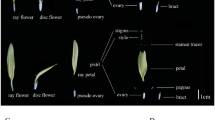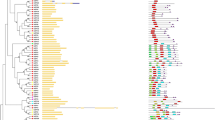Abstract
Abstract
The complex capitulum of Chrysanthemum morifolium is often comprised of bilaterally symmetrical ray florets and radially symmetrical disc florets. The TCP transcription factor clade CYCLOIDEA2 (CYC2) appears to play a vital role in determining floral symmetry and in regulating floral organ development in Asteraceae. Our previous study identified six CmCYC2 genes from chrysanthemum and showed that CmCYC2c participated in the regulation of ray floret identity. However, the functions of other CmCYC2 genes and the underlying molecular mechanism of CmCYC2-mediated floral development regulation in chrysanthemums have not been elucidated. In this study, we analysed the function of CmCYC2 genes by ectopic expression of CmCYC2 in Arabidopsis. Then, we examined the protein–protein interaction using yeast two-hybrid (Y2H) and bimolecular fluorescence complementation (BiFC) assays. Finally, we analysed the protein-DNA interaction using yeast one-hybrid (Y1H) and dual-luciferase reporter assays. We found that ectopic expression of CmCYC2 genes in the Arabidopsis tcp1 mutant changed its floral symmetry and flowering time. Y2H and BiFC assays confirmed three pairs of interactions between CmCYC2 proteins, that is, CmCYC2b-CmCYC2d, CmCYC2b-CmCYC2e and CmCYC2c-CmCYC2d, suggesting that heterodimeric complexes may form between CmCYC2 proteins to increase their functional specificity. The results of Y1H and dual-luciferase reporter assays indicate that CmCYC2c can bind to the promoter of ClCYC2f. Our findings provided clues that CmCYC2-like transcription factors may interact with each other or bind to the promoter to regulate floral symmetry development in C. morifolium.
Key message
CmCYC2-like transcription factors may interact with each other or bind to the promoter to regulate floral symmetry development in Chrysanthemum morifolium.







Similar content being viewed by others
References
Abbott RJ (1984) Polymorphism for outcrossing frequency at the ray floret locus in S vulgaris LI evidence. Heredity 52:331–336
Alonso JM, Stepanova AN, Leisse TJ, Kim CJ, Chen HM, Shinn P, Stevenson DK, Zimmerman J, Barajas P, Cheuk R, Gadrinab C, Heller C, Jeske A, Koesema E, Meyers CC, Parker H, Prednis L, Ansari Y, Choy N, Deen H, Geralt M, Hazari N, Hom E, Karnes M, Mulholland C, Ndubaku R, Schmidt I, Guzman P, Aguilar-Henonin L, Schmid M, Weigel D, Carter DE, Marchand T, Risseeuw E, Brogden D, Zeko A, Crosby W, Berry CC, Ecker JR (2003) Genome-wide insertional mutagenesis of Arabidopsis thaliana. Science 301(5633):653–657
Andersson S (2008) Pollinator and nonpollinator selection on ray morphology in Leucanthemum vulgare (oxeye daisy, Asteraceae). Am J Bot 95:1072–1078
Bello MA, Cubas P, Alvarez I, Sanjuanbenito G, Fuertes-Aguilar J (2017) Evolution and expression patterns of CYC/TB1 genes in Anacyclus: phylogenetic insights for floral symmetry genes in Asteraceae. Front Plant Sci 8:589. https://doi.org/10.3389/fpls.2017.00589
Bemer M, van Dijk ADJ, Immink RGH, Angenent GC (2017) Cross-family transcription factor interactions: an additional layer of gene regulation. Trends Plant Sci 22:66–80. https://doi.org/10.1016/j.tplants.2016.10.007
Broholm SK, Tahtiharju S, Laitinen RA, Albert VA, Teeri TH, Elomaa P (2008) A TCP domain transcription factor controls flower type specification along the radial axis of the Gerbera (Asteraceae) inflorescence. Proc Natl Acad Sci USA 105:9117–9122. https://doi.org/10.1073/pnas.0801359105
Broholm SK, Teeri TH, Elomaa P (2014) Chapter ten–molecular control of inflorescence development in Asteraceae. Adv Bot Res 72:297–333
Busch A, Zachgo S (2009) Flower symmetry evolution: towards understanding the abominable mystery of angiosperm radiation. BioEssays 31:1181–1190. https://doi.org/10.1002/bies.200900081
Chapman MA, Leebens-Mack JH, Burke JM (2008) Positive selection and expression divergence following gene duplication in the sunflower CYCLOIDEA gene family. Mol Biol Evol 25:1260–1273. https://doi.org/10.1093/molbev/msn001
Chapman MA, Tang SX, Draeger D, Nambeesan S, Shaffer H, Barb JG, Knapp SJ, Burke JM (2012) Genetic analysis of floral symmetry in Van Gogh’s sunflowers reveals independent recruitment of CYCLOIDEA genes in the Asteraceae. PLoS Genet 8:e1002628. https://doi.org/10.1371/journal.pgen.1002628
Corley SB, Rosemary C, Lucy C, Enrico C (2005) Floral asymmetry involves an interplay between TCP and MYB transcription factors in Antirrhinum. Proc Natl Acad Sci USA 102:5068–5073
Costa MMR, Samantha F, Hanna AI, Catherine B, Enrico C (2005) Evolution of regulatory interactions controlling floral asymmetry. Development 132:5093–5101
Cubas P, Lauter N, Doebley J, Coen E (1999) The TCP domain: a motif found in proteins regulating plant growth and development. Plant J 18:215–222
Danisman S, van Dijk AD, Bimbo A, van der Wal F, Hennig L, de Folter S, Angenent GC, Immink RG (2013) Analysis of functional redundancies within the Arabidopsis TCP transcription factor family. J Exp Bot 64:5673–5685. https://doi.org/10.1093/jxb/ert337
Elomaa P, Zhao YF, Zhang T (2018) Flower heads in Asteraceae-recruitment of conserved developmental regulators to control the flower-like inflorescence architecture. Hortic Res 5:10. https://doi.org/10.1038/s41438-018-0056-8
Fambrini M, Pugliesi C (2016) CYCLOIDEA 2 clade genes: key players in the control of floral symmetry, inflorescence architecture, and reproductive organ. Dev Plant Mol Biol Rep 35:20–36. https://doi.org/10.1007/s11105-016-1005-z
Fambrini M, Salvini M, Pugliesi C (2011) A transposon-mediate inactivation of a CYCLOIDEA-like gene originates polysymmetric and androgynous ray flowers in Helianthus annuus. Genetica 139:1521–1529. https://doi.org/10.1007/s10709-012-9652-y
Fambrini M, Basile A, Salvini M, Pugliesi C (2014) Excisions of a defective transposable CACTA element (Tetu1) generate new alleles of a CYCLOIDEA-like gene of Helianthus annuus. Gene 549:198–207. https://doi.org/10.1016/j.gene.2014.07.018
Garces HM, Spencer VM, Kim M (2016) Control of floret symmetry by RAY3, SvDIV1B, and SvRAD in the capitulum of senecio vulgaris. Plant Physiol 171:2055–2068. https://doi.org/10.1104/pp.16.00395
Gillies ACM, Cubas P, Coen ES, Abbott RJ (2002) Making rays in the Asteraceae: genetics and evolution of radiate versus discoid flower heads. Dev Genet Plant Evol 65:233–246
Hileman LC (2014) Bilateral flower symmetry–how, when and why? Curr Opin Plant Biol 17:146–152. https://doi.org/10.1016/j.pbi.2013.12.002
Howarth DG, Donoghue MJ (2006) Phylogenetic analysis of the "ECE" (CYC/TB1) clade reveals duplications predating the core eudicots. Proc Natl Acad Sci USA 103:9101–9106. https://doi.org/10.1073/pnas.0602827103
Huang D, Li XW, Sun M, Zhang TX, Pan HT, Cheng TR, Wang J, Zhang QX (2016) Identification and characterization of CYC-like genes in regulation of ray floret development in Chrysanthemum morifolium. Front Plant Sci 7:1633. https://doi.org/10.3389/fpls.2016.01633
Immink RG, Kaufmann K, Angenent GC (2010) The 'ABC' of MADS domain protein behaviour and interactions. Semin Cell Dev Biol 21:87–93. https://doi.org/10.1016/j.semcdb.2009.10.004
Juntheikki-Palovaara I, Tahtiharju S, Lan TY, Broholm SK, Rijpkema AS, Ruonala R, Kale L, Albert VA, Teeri TH, Elomaa P (2014) Functional diversification of duplicated CYC2 clade genes in regulation of inflorescence development in Gerbera hybrida (Asteraceae). Plant J 79:783–796. https://doi.org/10.1111/tpj.12583
Kim M, Cui ML, Cubas P, Gillies A, Lee K, Chapman MA, Abbott RJ, Coen E (2008) Regulatory genes control a key morphological and ecological trait transferred between species. Science 322:1116–1119. https://doi.org/10.1126/science.1164371
Kosugi S, Ohashi Y (2002) DNA binding and dimerization specificity and potential targets for the TCP protein family. Plant J 30:337–348
Luo D, Carpenter R, Vincent C, Copsey L, Coen E (1996) Origin of floral asymmetry in Antirrhinum. Nature 383:794–799
Luo D, Carpenter R, Copsey L, Vincent C, Clark J, Coen E (1999) Control of organ asymmetry in flowers of Antirrhinum. Cell 99:367–376
Martin-Trillo M, Cubas P (2010) TCP genes: a family snapshot ten years later. Trends Plant Sci 15:31–39. https://doi.org/10.1016/j.tplants.2009.11.003
Mizzotti C, Fambrini M, Caporali E, Masiero S, Pugliesi C (2015) A CYCLOIDEA-like gene mutation in sunflower determines an unusual floret type able to produce filled achenes at the periphery of the pseudanthium. Botany 93:171–181. https://doi.org/10.1139/cjb-2014-0210
Preston JC, Hileman LC (2009) Developmental genetics of floral symmetry evolution. Trends Plant Sci 14:147–154
Song C, Liu YF, Song AP, Dong GQ, Zhao HB, Sun W, Ramakrishnan S, Wang Y, Wang SB, Li TZ, Niu Y, Jiang JF, Dong B, Xia Y, Chen SM, Hu ZG, Chen FD, Chen SL (2018) The Chrysanthemum nankingense genome provides insights into the evolution and diversification of chrysanthemum flowers and medicinal traits. Mol Plant 11:1482–1491. https://doi.org/10.1016/j.molp.2018.10.003
Tahtiharju S, Rijpkema AS, Vetterli A, Albert VA, Teeri TH, Elomaa P (2012) Evolution and diversification of the CYC/TB1 gene family in Asteraceae: a comparative study in Gerbera (Mutisieae) and sunflower (Heliantheae). Mol Biol Evol 29:1155–1166. https://doi.org/10.1093/molbev/msr283
Yang X, Cui H, Yuan ZL, Wang YZ (2010) Significance of consensus CYC-binding sites found in the promoters of both ChCYC and ChRAD genes in Chirita heterotricha (Gesneriaceae). J Syst Evol 48:249–256
Yang X, Pang HB, Liu BL, Qiu ZJ, Gao Q, Wei L, Dong Y, Wang YZ (2012) Evolution of double positive autoregulatory feedback loops in CYCLOIDEA2 clade genes is associated with the origin of floral zygomorphy. Plant Cell 24:1834–1847
Yang Y, Sun M, Yuan CQ, Han Y, Zheng TC, Cheng TR, Wang J, Zhang QX (2019) Interactions between WUSCHEL- and CYC2-like transcription factors in regulating the development of reproductive organs in Chrysanthemum morifolium. Int J Mol Sci 20:1276
Zhao K, Zhou Y, Li Y, Zhuo X, Ahmad S, Han Y, Yong X, Zhang Q (2018) Crosstalk of PmCBFs and PmDAMs based on the changes of phytohormones under seasonal cold stress in the stem of Prunus mume. Int J Mol Sci 25:689. https://doi.org/10.3390/ijms19020015
Zhou YZ, Xu ZD, Yong X, Ahmad S, Yang WR, Cheng TR, Wang J, Zhang QX (2017) SEP-class genes in Prunus mume and their likely role in floral organ development. BMC Plant Biol 17:10. https://doi.org/10.1186/s12870-016-0954-6
Acknowledgements
This work was supported by the Fundamental Research Funds for the National Natural Science Foundation of China (31700621), National Science and Technology Program during the Twelfth Five-year Plan (2012BAD01B07, 2013BAD01B07), Special Fund for Beijing Common Construction Project and Fundamental Research Funds for the Central Universities (BLX2015-03).
Author information
Authors and Affiliations
Contributions
CY, DH, YY, MS and QZ conceived and designed the experiments. DH and YY performed the experiments. DH, YY and CY analysed the data. JW, HP and TC contributed to the experimental design and data analysis. CY wrote the manuscript. All authors read and approved the manuscript.
Corresponding author
Ethics declarations
Conflict of interest
The authors declare that they have no conflict of interest.
Additional information
Publisher's Note
Springer Nature remains neutral with regard to jurisdictional claims in published maps and institutional affiliations.
Electronic supplementary material
Below is the link to the electronic supplementary material.
Rights and permissions
About this article
Cite this article
Yuan, C., Huang, D., Yang, Y. et al. CmCYC2-like transcription factors may interact with each other or bind to the promoter to regulate floral symmetry development in Chrysanthemum morifolium. Plant Mol Biol 103, 159–171 (2020). https://doi.org/10.1007/s11103-020-00981-5
Received:
Accepted:
Published:
Issue Date:
DOI: https://doi.org/10.1007/s11103-020-00981-5




